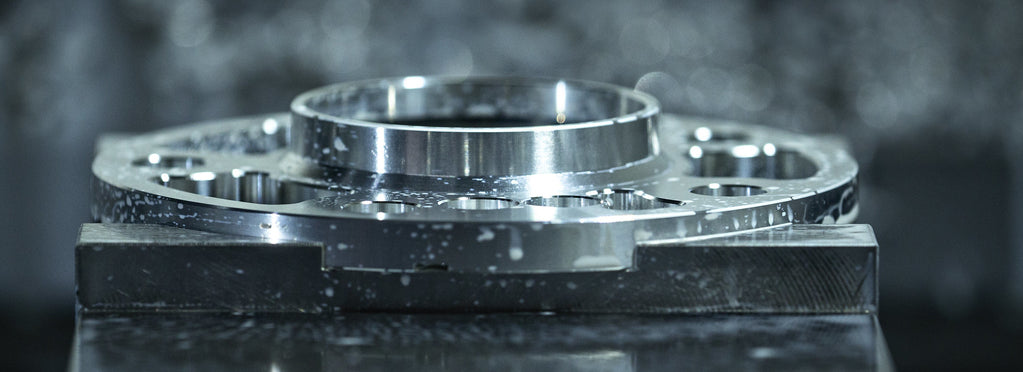
How It's Made: Future Classic Wheel Spacers (for BMW and Porsche)
IND Distribution July 02, 2020
Literally every FC motorsport component is designed, manufactured, and motorsport tested right here in the USA.
Spacers have been used in motorsport applications for over forty years, but despite the rest of the industry rapidly progressing, this part has gone strangely neglected and overlooked from an engineering standpoint.
Nowadays, handfuls of popular spacer companies have moved production overseas in pursuit of profit. There, spacers have become prone to poor manufacturing methods and lack of quality control. The result of this shift toward inferior production control is most often wheel wobble (shake) caused by an imbalanced / unevenly manufactured spacer, which causes it to be ill-seated against the hub or wheel mating surfaces even with the most careful installation. Coupling this with a slew of misinformation and lack of transparency from spacer companies have devalued an otherwise useful component—dreadful wheel wobble has just become par for the course instead of an inexcusable symptom.

Each Future Classic spacer kit includes spacers, hub bolts, lug bolts, Copaslip motorsport copper anti-seize, and an applicator brush
We at Future Classic have literally engineered the spacer from the ground up, from ideation to meticulous packaging. Rather than settle for simple holes punched into aluminum, each application has been intelligently designed for optimum performance, whether on the street or on track where every second counts. Unlike any other offering on the market, these spacers are bolted to the hub for easier wheel mounting and make for faster pit stops since the spacer will stay put during rapid wheel changes.. Because of our incredibly tight tolerances during the manufacturing process, the hub bolts also guard against improper installation, ensuring integral mating between the hub, spacer, and wheel surfaces.
To stand up against legitimate motorsport testing, only the very best manufacturing equipment would do—we trust DMG Mori to uphold the standards we set for ourselves. The motor spindles in the “MASTER” series from the DMG MORI component portfolio now excel through a failure rate of less than 1% which is exceptional. Unlike other manufacturers that can use anodizing to hide manufacturing imperfections, our entire lineup of parts come out as beautiful as ever with zero machining flaws.—our hard coat anodizing, which is 8x stronger and wear resistant than standard anodizing, is just the cherry on top.

Production Stages: 6061-T6 after cutting, lathe, then finished with hard coat anodizing
In the name of transparency, we wanted to give our fans an inside look into how our coveted BMW and Porsche spacers are made from start to finish right here in the USA.
Upon receipt of over 500lbs of 6061-T6 aircraft grade aluminum, the enormous bars are lifted onto the saw and are cut down to more manageable pieces over the course of a couple weeks. Once complete, each piece is taken through two programmed stages on the lathe. Each program works through very specific instructions to take the raw block of aluminum down to the spacer's form—one set of parameters per side. Tooling is changed at regular intervals and holding pressure constantly monitored and adjusted—an important series, yet often overlooked steps by other manufacturers, to guarantee consistency in production.

Door to the lathe open to change tools at regular intervals

Spacers in the queue after first lathe cutting pass

Close-up: Raw 6061-T6 aluminum on one side, first lathe pass on other

Another close-up view of stage one and stage two lathe cutting programs
Once the spacers have finished both stages on the lathe, they are moved to the DMG Mori vertical mill where the lug bolt holes, hub bolt provisions, lightening pockets, and chamfered edges are relieved from the material. The DMG Mori is a CELOS machine with up to 60 sensors for accurate monitoring and supervision of each process, including tolerance, tool changes, and adequate coolant feed.




It's a wonderful thing to pick up a freshly milled spacer—it is a far cry from its raw form and beautiful to behold. From here, each spacer undergoes hard coat anodizing. Type III (hardcoat) anodizing is an electrochemical process that forms an extremely hard, abrasion resistant, porous oxide on aluminum. As aforementioned, it is much stronger—usually 8x than standard anodizing practices.

To finish, each hard coat anodized spacer is legibly lasered with the FC logo and its corresponding part number. "BWSK" indicates a BMW production piece whereas "PWSK" is designed for use on Porsche. There are typically three numbers that follow the application designation—this number set refers to the spacer size (for example, 010 means 10mm spacer). Select BMW spacers will feature an additional 112 engraving for newer 5x112 applications at the tail end of the typical three digit string.



It's a massive testament that some of the biggest names in the automotive industry trust Future Classic equipment to help propel them to victory. Our products are continuously motorsport tested and legitimately excel at this level across applications—another claim that many manufacturers cannot match and an enormous peace of mind when you're shopping for your next set of mods. Check out the video below to see everything in action!

